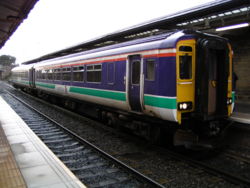Newcastle and Carlisle Railway
| Newcastle and Carlisle Railway |
| Stations (from east to west) Newcastle |
The Newcastle and Carlisle Railway, also known as the Tyne Valley Line, is a railway line in northern England. The 60 mile (96 km) line was built in the 1830s, and links the city of Newcastle upon Tyne in Tyne and Wear with Carlisle in Cumbria.
The line follows the course of the River Tyne through Northumberland. Five stations and two viaducts on the route are listed structures.
Passenger services on the Tyne Valley Line are operated by Northern Rail and First ScotRail. The line is also heavily used for freight, and is an important diversionary route during East Coast Main Line closures.
Route
Immediately after crossing the Tyne from Newcastle, the Newcastle and Carlisle diverges from the southbound East Coast Main Line and passes west through Gateshead, with stations at Dunston, Metro Centre and Blaydon. Originally it would have run along the north bank of the Tyne for around four miles, serving the Sir W G Armstrong & Co works at Elswick, before crossing the Tyne at Scotswood and rejoining its current route along the south bank from Blaydon.
Past Blaydon, the line enters Northumberland and passes Wylam station. The station house at Wylam was built in 1835, and is Grade II* listed. Other principal stops in Northumberland include Prudhoe, Corbridge, Hexham and Haltwhistle.
In Cumbria, the Tyne Valley line serves Brampton Junction and Wetheral stations. The line joins the Settle-Carlisle Railway just before reaching Carlisle Citadel station.
The full list of towns and villages served by the line are listed below.
- Newcastle upon Tyne
- Dunston
- Metro Centre
- Blaydon
- Wylam
- Prudhoe
- Stocksfield
- Riding Mill
- Corbridge
- Hexham
- Haydon Bridge
- Bardon Mill
- Haltwhistle
- Brampton
- Wetheral
- Carlisle
History
The railway was built by the Newcastle and Carlisle Railway Company, gaining Royal Assent on 22 May 1829. The line was built in sections from 1834 onwards; the entire route between Carlisle London Road station and Redheugh in Gateshead was formally opened to passengers on 18 June 1838. A temporary Tyne bridge was built at Scotswood to allow trains to reach a terminus in Newcastle - this opened on 21 October 1839. N&CR trains first used Newcastle Central Station on 1 January 1851.
The N&CR was absorbed into the North Eastern Railway on 17 July 1862. From 1864, trains ran to Carlisle Citadel station, and the old London Road station was closed. In 1870, the temporary bridge at Scotswood was removed - a new iron bridge, the Scotswood Bridge, was built to replace it.
A north Tyne route - the North Wylam loop - was constructed for colliery and passenger traffic in the mid-1870s. It diverged from the original N&CR at Scotswood, ran along the north bank of the Tyne, and crossed the river at Wylam where it joined the N&CR again. Stations were built at Newburn, Lemington and North Wylam. The North Wylam loop fell under the Beeching Axe in the 1960s, and closed to passengers on 11 March 1968.
On 4 October 1982, British Rail closed the Scotswood Bridge, which had become uneconomical to maintain. Tyne Valley trains from Newcastle were diverted to use the present route, crossing the King Edward Bridge south-west of Newcastle Central Station, and running via Dunston to Blaydon.
Former stations on the line include Scotswood, Elswick, Greenhead and Gilsland.
Branch Lines
Originally the railway had three branch lines leading off it:
- The Border Counties Railway branched off just west of Hexham and passed through Kielder and the North Tyne Valley, before joining up with the Scottish rail network near Hawick. It was also linked to the branch line from Rothbury. It was a victim of the Beeching Axe, closing in the mid-1960s.
- The Allendale branch came off near the village of Haydon Bridge and was primarily used to carry minerals from mines and quarries around Allendale and the village of Langley. It was never popular with passenger services ending in the 1930s and the line closed completely in 1953.
- The Alston branch covered 17 miles from the town of Haltwhistle. This branch provided a passenger services and also, in the early days, served the hundreds of lead mines in the upper South Tyne Valley. It included the momumental Lambley Viaduct and was the last of the branch lines to close in 1976.
Rolling Stock
The line is not an electrified route; passenger services are therefore operated by diesel multiple units, typically Class 142 "Pacers" and Class 156 "Super Sprinters" which were introduced in the late 1980s. Prior to this, Metro-Cammell Class 101 units were used.
| Wikimedia Commons has media related to: Tyne Valley Line |
External links


